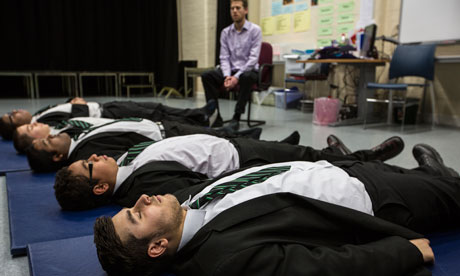
Many year 11 students have recently been sitting GCSE mock exams. It is a stressful time. One teenager, Jess, describes her state of mind. "I was so nervous before the English language exam," she says. "I did, like, twenty 7/11s."
A "7/11" is not the latest in teenage kicks, but a breathing exercise characteristic of a movement that is undergoing a surge in popularity in schools, known as "mindfulness". The 7/11 is a relaxation breathing exercise. Matching the counting to the breath, you breathe in for a count of seven, and out for a count of 11. It works for teachers, too.
Another technique much in evidence under mindfulness is called "beditation" – again, not something to panic a teenager's parents, but simply the practice of meditation while lying down.
About 3,000 students in Britain have been taught mindfulness techniques, and numbers are growing. This month there will be the first international conference on mindfulness in schools, in London, where teachers and experts will gather and Prof Willem Kuyken, who heads a mindfulness research unit at Exeter University, will present some new results.
The "7/11" and "beditation" techniques are being taught in schools through a programme called ".b" (Stop, Breathe and Be) designed by two teachers, Richard Burnett and Chris Cullen, who together formed the Mindfulness in Schools Project in 2007. "We were both finding great benefits from mindfulness ourselves," says Cullen, "and had started introducing simple mindfulness practices to classes in the schools where we taught. The response from students was striking and inspired us to create a programme that they would find fun, accessible and of genuine use in their lives." The course is now being taught in 12 countries.
Mindfulness in a nutshell is the practice of becoming aware of what is happening in the present moment and of learning to relate more skilfully to thoughts, emotions, body sensations and impulses as they arise.
The methods have developed over 2,500 years, from roots in eastern philosophy. One of the reasons for the interest is the fact that no religion or spirituality is involved. In the west, it was American molecular biologist Jon Kabat-Zinn who began to develop an eight-week meditation programme for patients at the hospital he worked in. This course became the Mindfulness Based Stress Reduction (MBSR) course.
The recent surge in popularity is also buoyed by backing from the scientific community. The evidence that mindfulness training reduced the rate of depressive relapse by about half led to its recommendation by the National Institute for Health and Clinical Excellence in 2004 as a treatment for depression, and there is a growing body of research suggesting that it can help to treat a range of mental-health problems, improve performance in sport and the performing arts, and bolster happiness and wellbeing.
At Bethnal Green academy, teacher Dominic Morris introduced mindfulness into his school after he read up on the subject and felt the techniques could have helped him though his own difficult teenage years. "My mind was all over the place and I was often worrying and playing things over and over," he says.
The principal at Bethnal Green academy, Mark Keary, was keen to support Morris in establishing mindfulness in the school, especially when he learned it could lead to improved concentration during lessons. The school, recently judged "outstanding" by Ofsted, serves a deprived area. "Mindfulness is a discipline that can help us tap into our students' potential," says Keary.
Morris began by teaching a group of year 7 students who, for one reason or another, were having difficult times. Students were soon saying they would use the techniques at home as well as in school. Now Morris is teaching the course to year 11 students after school. His students have said it helps them to sleep and to focus, and one boy said it helped him to stay calm when his brother was aggressive at home. One 16-year-old boy, keen to succeed, uses the techniques to calm himself in lessons where a peer frequently plays up.
I also took the MBSR course and then did a four-day residential course at Bangor University to train to teach the .b course in school. Jenny Stephen, my headteacher, supports the idea and the .b course is currently being taught to all year 7 and year 10 students. "Young people live in a fast-paced and confusing world," says Stephen. "The expectations that parents and society place on students are so high. To be able to step back and appreciate yourself for who you are, and be able to stop the plates spinning is a gift. Mental wellbeing is at the route of being able to achieve anything."
Ally, a student at my school, explains why she attends mindfulness club at lunchtime. "It's just 15 minutes of quiet under a table," she says. "I don't necessarily find solutions to problems or anything, but I do come to terms with what's happening around me."
Ally says she has even been known to go through a 15-minute guided meditation with her friends before going off to a party. I dunno, teenagers these days …
• Oenone Crossley-Holland is a teacher at South Hampstead high school, London. For mindfulness resources, go to theguardian.com/teacher-network

